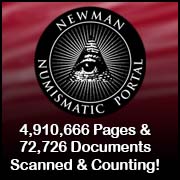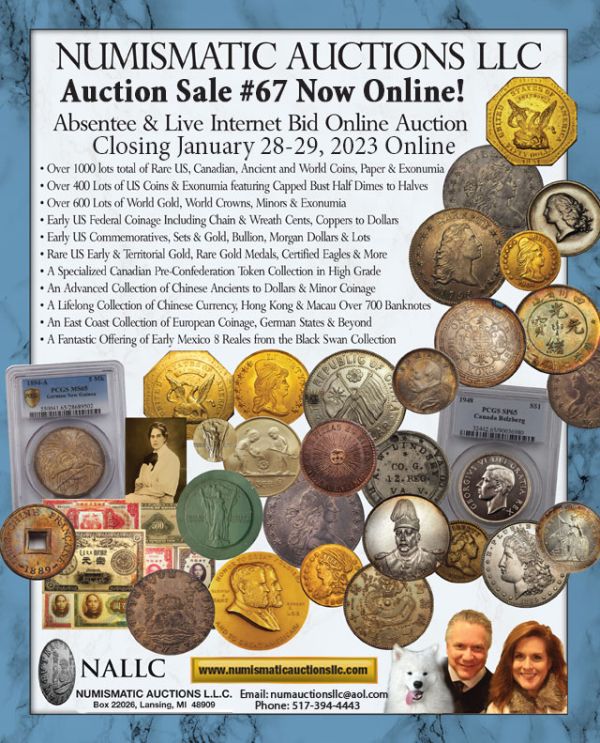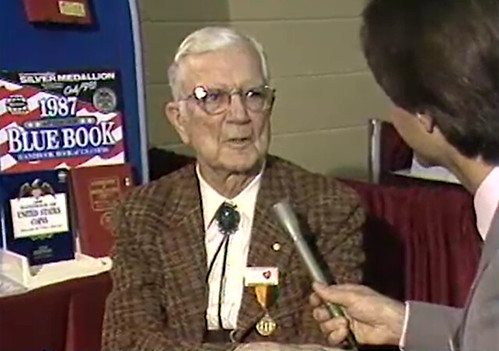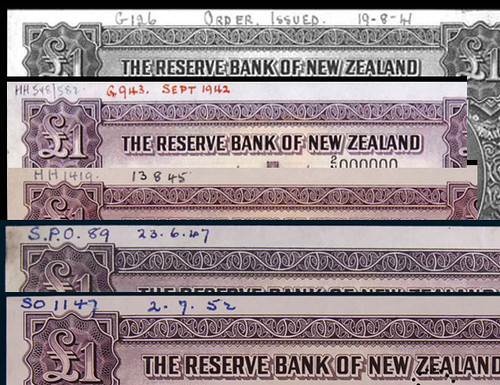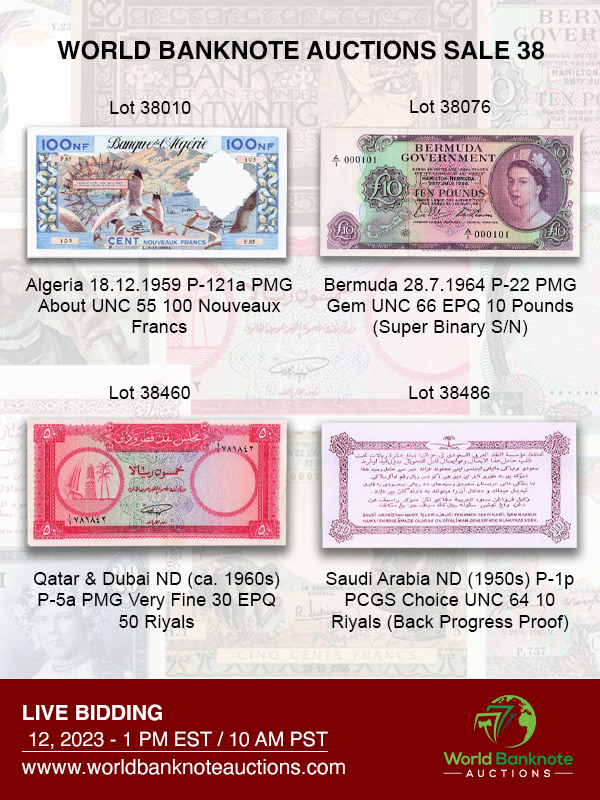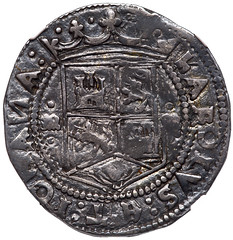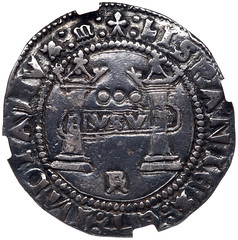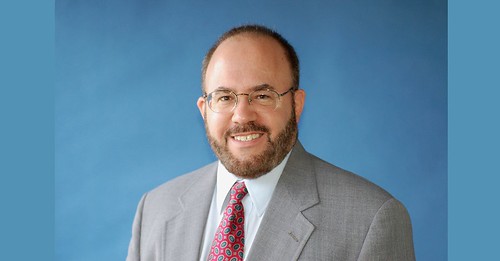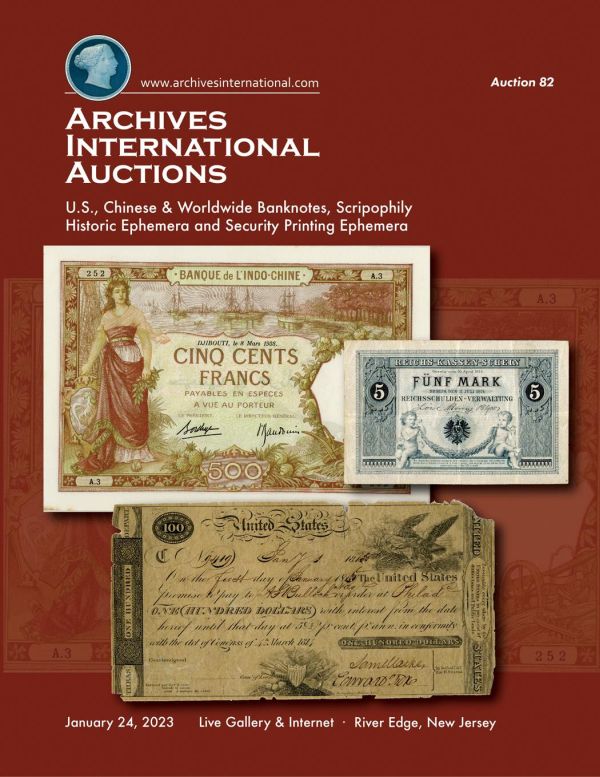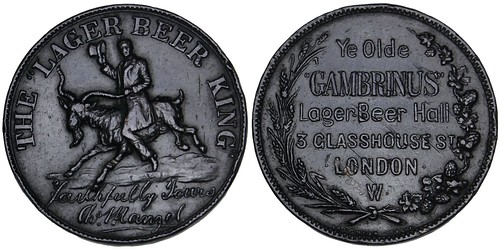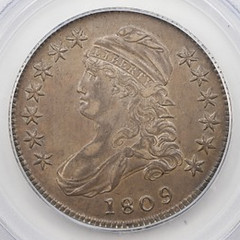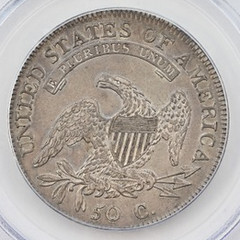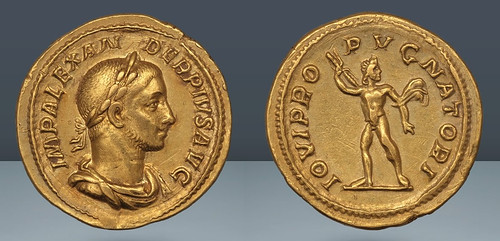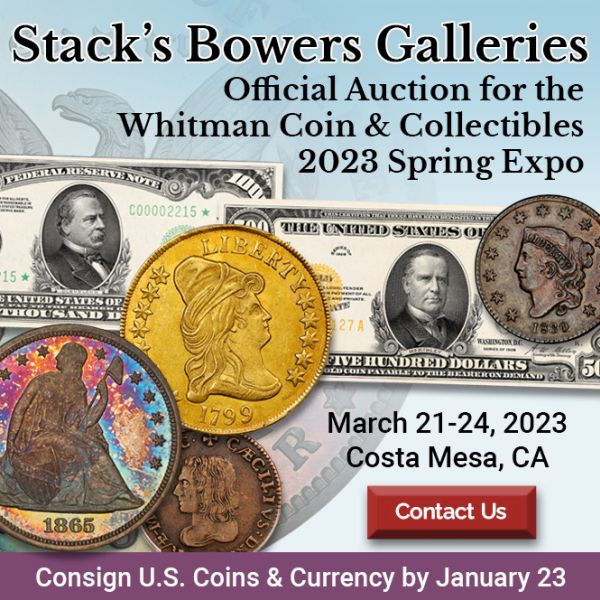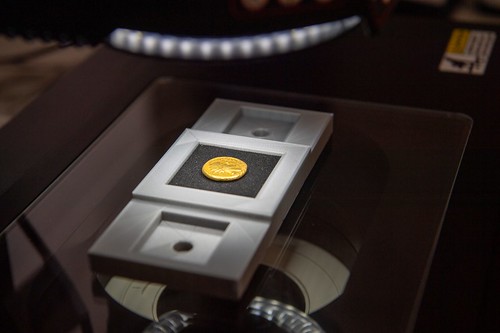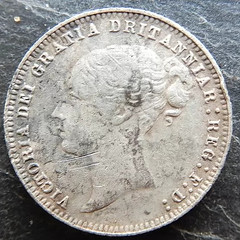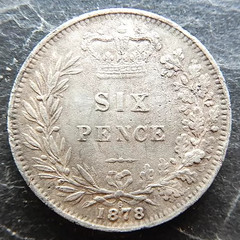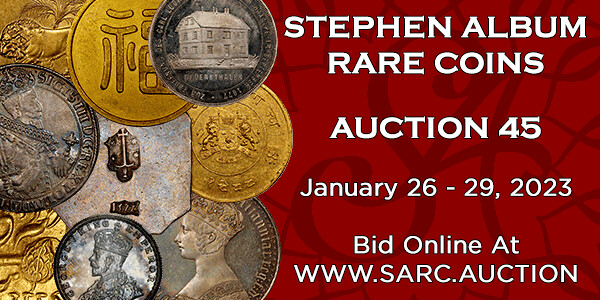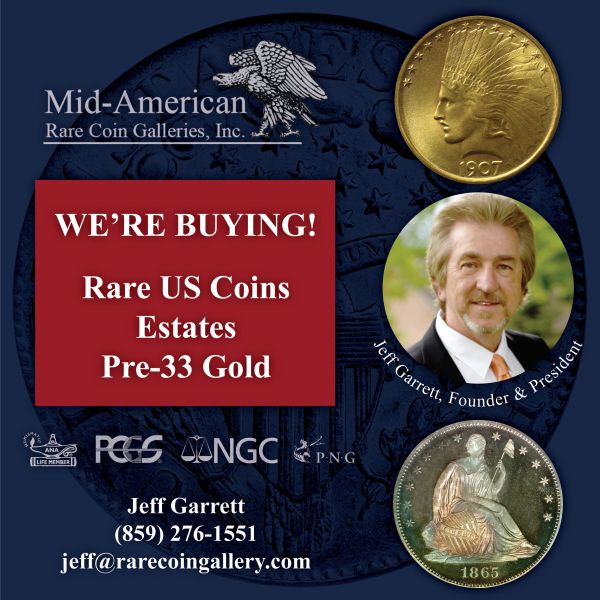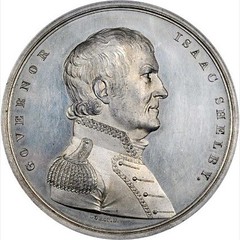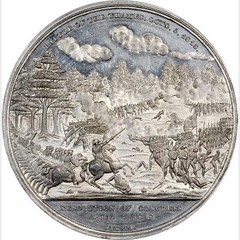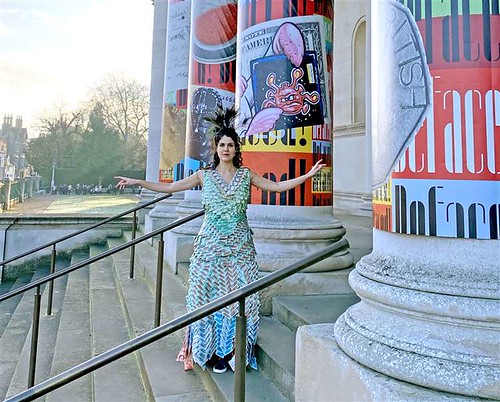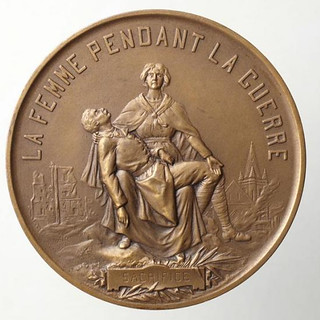
Visit our NBS Sponsors




About UsThe Numismatic Bibliomania Society is a non-profit association devoted to the study and enjoyment of numismatic literature. For more information please see our web site at coinbooks.org SubscriptionsThose wishing to become new E-Sylum subscribers (or wishing to Unsubscribe) can go to the following web page link MembershipThere is a membership application available on the web site Membership Application To join, print the application and return it with your check to the address printed on the application. Print/Digital membership is $40 to addresses in the U.S., and $60 elsewhere. A digital-only membership is available for $25. For those without web access, write to: Charles Heck, Treasurer AsylumFor Asylum mailing address changes and other membership questions, contact Chuck at this email address: treasurer@coinbooks.org SubmissionsTo submit items for publication in The E-Sylum, write to the Editor at this address: whomren@gmail.com BUY THE BOOK BEFORE THE COINSale CalendarWatch here for updates! |
- WAYNE'S WORDS: THE E-SYLUM JANUARY 22, 2023
- KOLBE & FANNING BUY OR BID SALE NUMBER 20
- NEW BOOK: LOS TLACOS DE VALLADOLID-MORELIA
- DAVID W. LANGE (1958-2023)
- NNP 1827 WILLIAM BROWN SOTHEBY'S CATALOG
- VIDEO: R.S. YEOMAN
- CHANGING TRENDS IN NUMISMATICS
- NOTES FROM E-SYLUM READERS: JANUARY 22, 2023
- TYRANT COLLECTION MEXICO-BRAZIL EXHIBIT
- NEW INTERNATIONAL MONEY EXPO (IMEX)
- VOCABULARY TERM: MINIATURE
- DAVID W. LANGE – RECOLLECTIONS
- REMEMBERING DAVID W. LANGE (1958–2023)
- NUMISMAGRAM MEDAL SELECTIONS: JANUARY 2023
- NUMISMATIC AUCTIONS SALE 67 U.S. HIGHLIGHTS
- NUMISMATIC NUGGETS: JANUARY 22, 2023
- WAYNE'S NUMISMATIC DIARY: JANUARY 22, 2023
- COINS OF THE KINGS OF BITHYNIA
- ANOTHER SPONSIAN ARTICLE
- COUNTERFEIT BUST DIME DIE MARRIAGES
- THE 1878 DRITANNIAR SIXPENCE
- PAUL MORGAN APPOINTED KING'S ASSAY MASTER
- 2022 COIN OF THE YEAR CATEGORY WINNERS
- FOIL-WRAPPED COINS
- THE MEDALS OF ISAAC SHELBY
- CAMBRIDGE ACTIVIST'S VENEZUELAN MONEY DRESS
- LOOSE CHANGE: JANUARY 22, 2023
- FEATURED WEBSITE: FRENCH SCULPTURE CENSUS
Click here to read the thin version on the web
Click here to subscribe
Click here to access the complete archive
To comment or submit articles, reply to whomren@gmail.com
Content presented in The E-Sylum is not necessarily researched or independently fact-checked, and views expressed do not necessarily represent those of the Numismatic Bibliomania Society.
WAYNE'S WORDS: THE E-SYLUM JANUARY 22, 2023
 New subscribers this week include:
Ric Burney and
Renato Schindler.
Welcome aboard!
New subscribers this week include:
Ric Burney and
Renato Schindler.
Welcome aboard!
Thank you for reading The E-Sylum. If you enjoy it, please send me the email addresses of friends you think may enjoy it as well and I'll send them a subscription. Contact me at whomren@gmail.com anytime regarding your subscription, or questions, comments or suggestions about our content.
This week we open with a numismatic literature sale, one new book, updates from the Newman Numismatic Portal, and more.
Other topics this week include Sotheby's catalogs, changing trends in numismatics, the Tyrant Collection, auction previews, counterfeit bust dimes, the Dritanniar sixpence, the King's Assay Master, foil-wrapped coins, a fire breathing dragon, Isaac Shelby, R. S. Yeoman, and Dave Lange.
To learn more about one of the good guys, brothel tokens, the Robbins Company, Miniature decorations, the Lager Beer King of London, the Catskill Aqueduct, a 1799 Gold Eagle, medals by Charles Cushing Wright, the Boggs NFTs, the Kings of Bithynia, the 2022 Coin of the Year competition, and the Venezuelan Money Dress, read on. Have a great week, everyone!
Wayne Homren
Editor, The E-Sylum
KOLBE & FANNING BUY OR BID SALE NUMBER 20
Numismatic Booksellers Kolbe & Fanning submitted this announcement of their twentieth "Buy or Bid Sale" which closes on January 30, 2023. Good luck, everyone! -Editor
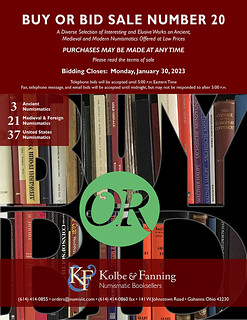 Kolbe & Fanning Numismatic Booksellers have announced our latest
Kolbe & Fanning Numismatic Booksellers have announced our latest Buy or Bid Sale,
which begins now and will close on Monday, January 30, 2023. With hundreds of new additions, the sale focuses on modestly priced books, giving collectors an opportunity to add to their libraries at minimal cost.
The sale includes over 1400 works on ancient, medieval and modern coins, as well as general works, periodicals and sale catalogues. Buy
prices have been kept low to promote sales. To further encourage participation, the firm is offering free domestic shipping to bidders spending at least $300; there is also no packing and processing fee for this sale. Again, please read the Terms of Sale before participating.
THE BOOK BAZARRE
NEW BOOK: LOS TLACOS DE VALLADOLID-MORELIA
Adrian Gonzalez Salinas passed along information about a new Mexican numismatic book published last year on the tokens of Valladolid-Morelia. Apparently it's already sold out, but be on the lookout for it in the secondary market. -Editor
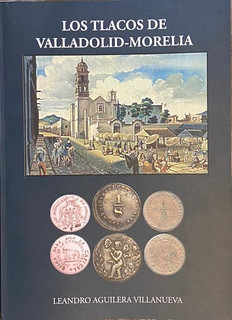 Title: "Los Tlacos de Valladolid-Morelia"
Title: "Los Tlacos de Valladolid-Morelia"
(The Tokens of Valladolid-Morelia)
Author: Leandro Aguilera Villanueva
Dimensions: 16.4 (W) x 22.6 (H) x 0.9 (T) cms
Pages: 135,(1)
Cover: Soft
Year: 2022 (printed August 2022)
Language: Spanish
# of Copies: 100
First edition
A "tlaco" was like a merchant or trade token and its value was an eighth of one real (12.5 / 8 = 1.5625 cents). It circulated in Mexico from the XVI century thru beginning of XX century."Tlacos" means "one half" in nahuatl language.
DAVID W. LANGE (1958-2023)
We were all shocked and saddened to learn this week of the passing of researcher, author and longtime E-Sylum contributor David Lange. E-Sylum Feature Writer and American Numismatic Biographies author Pete Smith submitted this bio/obituary. Thank you. Elsewhere in this issue we have Pete's second, more personal article, as well as one by Dennis Tucker. -Editor
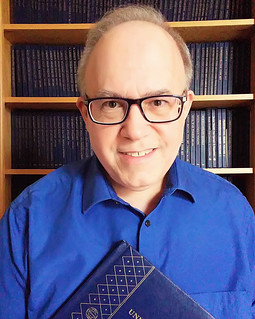 David W. Lange was a popular writer and friendly face at the NGC table during the ANA
conventions. He was born in San Francisco on August 29. 1958. He graduated from San Mateo
College and was employed as a senior design drafter for Pacific Gas and Electric from 1980 to
1994.
David W. Lange was a popular writer and friendly face at the NGC table during the ANA
conventions. He was born in San Francisco on August 29. 1958. He graduated from San Mateo
College and was employed as a senior design drafter for Pacific Gas and Electric from 1980 to
1994.
Dave began collecting coins in 1965 and was active with numismatic organizations in the Bay
Area. He served as president of the Liberty Numismatic Society and the Pacific Coast
Numismatic Society in 1988 to 1989. Later he was president of the California State Numismatic
Society 1993 to 1994. In 1994 he served on M.I.N.T.
(Maintain and Improve a Numismatic
Treasure) which was a mayor's committee to save the old San Francisco Mint Museum. In
addition to collecting U.S. coins series, he collected coinage of the Philippines and wrote that
chapter for the Red Book.
NNP 1827 WILLIAM BROWN SOTHEBY'S CATALOG
One of the many important catalog series digitized by the Newman Numismatic Portal is Sotheby's. Project Coordinator Len Augsburger provided the following report. -Editor
Newman Portal User Brings to Life an 1827 Sotheby's Catalog
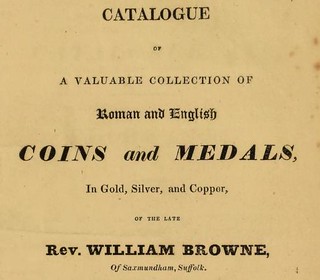 The Sotheby's auction sale catalog series is one of the most extensive in numismatics, with examples dated from 1795 to the present day. In cooperation with the American Numismatic Society, Newman Portal has scanned 1,047 of these catalogs, covering through the year 1923. Newman Portal user Rob Potter (UK) recently wrote us about the Sotheby's June 11, 1827 catalog:
The Sotheby's auction sale catalog series is one of the most extensive in numismatics, with examples dated from 1795 to the present day. In cooperation with the American Numismatic Society, Newman Portal has scanned 1,047 of these catalogs, covering through the year 1923. Newman Portal user Rob Potter (UK) recently wrote us about the Sotheby's June 11, 1827 catalog: It is amazing that you have this and have published it for all to see. I've been researching the life (or rather the death) of Rev. William Brown, whose property this was.
Rev. William Brown (c. 1755-1826) was rector at St. John the Baptist, Saxmundham, Suffolk, from 1798-1826, with his death apparently caused by a horse fall. Oral tradition in the family holds that William's son later fell in love with a servant and was forced to move to America in light of the scandal. Potter also located a separate sale of Rev. Brown's numismatic books, conducted by Mr. Cana
in 1827. This included well-known works such as Folke's Tables of English Gold and Silver Coins (1745) and Evelyn's Discourse of Ancient and Modern Medals (1697).
VIDEO: R.S. YEOMAN
The David Lisot Video Library on the Newman Numismatic Portal can be found at:
https://nnp.wustl.edu/library/multimediadetail/522852
We highlight one of his videos each week in The E-Sylum. Here's one from 1986 with the original "Mr. Redbook", Dick Yeo, a.k.a. R.S. Yeoman. -Editor
CHANGING TRENDS IN NUMISMATICS
This NGC blog article by Jeff Garrett illuminates the changes in the hobby alluded to in the previous article interviewing R. S. Yeoman in the mid-1980s and discusses trends long before and after that time, up to today's world of the billionaire collector (see the article on Dan O'Dowd's Tyrant Collection elsewhere in this issue). -Editor
In recent years, the demand for rare coins in the top-end of the marketplace has soared. Multi-million-dollar hammer prices have become common place. Last night, an NGC-certified ancient coin sold to an American buyer for $1.9 million dollars. The most recent collecting trend that continues to amaze me has been the emergence of mega-rich collectors battling for the finest and rarest. There are at least four to six billionaires actively collecting coins, each of which has invested at least $200 million in their collection.
NOTES FROM E-SYLUM READERS: JANUARY 22, 2023
Answer: Notations on Specimen Notes
Responding to Robert Pepping's questions about notations on Specimen Notes of the Reserve Bank of New Zealand,
Raphael Dvir of Israel writes:
"The annotations are references as appeared in "The Crown Agents Requisition Books - a compilation of currency and postal supply orders. It was a common practice by TDLR in their printer's copy specimen of each and every banknote, currency note and stamps they have printed. In the case of unadopted design, it represents the shipment reference to the designed country for examination by local officials."
Thank you! Raphael has written extensively on the paper money of Palestine and Israel. -Editor
To read the earlier E-Sylum article, see:
NOTES FROM E-SYLUM READERS: JANUARY 15, 2023 : Query: Notations on Specimen Notes
(https://www.coinbooks.org/v26/club_nbs_esylum_v26n03.html#article12)
Other topics this week include U.S. Brothel Tokens, and the Robbins Company. -Editor
TYRANT COLLECTION MEXICO-BRAZIL EXHIBIT
The Tyrant collection juggernaut continues. This press release describes an exhibit of the collection's Mexican and Brazilian coins at the upcoming Long Beach show. -Editor
Important early coins of Mexico and Brazil from the unparalleled Tyrant Collection (www.TheTyrantCollection.com) will be publicly displayed together for the first time at the Long Beach Coin, Currency Stamp & Sports Collectible Show (www.LongBeachExpo.com), February 2 - 4, 2023.
Entitled Tyrants of the New World,
this will be the latest multi-million-dollar exhibition in a multi-year series of different displays of portions of the extensive and unprecedented Tyrant Collection. Owned by Southern California collector Dan O'Dowd, it is described as the world's most valuable rare coin collection in private hands.
NEW INTERNATIONAL MONEY EXPO (IMEX)
Here are two press releases on the planned new International Money Expo. -Editor
Colonel Steven Ellsworth, ret. has announced the 1st Annual International Money Exposition. The convention and show will be held October 26th through 29th, 2023 at the Music City Center, Downtown Nashville, Tennessee. The event will be known as IMEX
.
This will not be just another coin show. It is destined to become a must attend event, held in a world class facility in the heart of one of the country's top destination cities, Nashville, Tennessee,
Music City USA
Ellsworth stated.
VOCABULARY TERM: MINIATURE
Here's another entry from Dick Johnson's Encyclopedia of Coin and Medal Terminology. -Editor
Miniature. A small medal of reduced size and exact design from a larger size issue. The smaller size medal serves several purposes, it offers a second variety, it facilitates several such miniature medals to be displayed together, and it offers a lighter weight badge for wearing. The dies for striking miniature medals are made from the same PATTERN, MODEL or DIESHELL as the larger medal. There are three kinds of medals where this term is used:
DAVID W. LANGE – RECOLLECTIONS
Pete Smith submitted this additional article with his recollections of David Lange. Thanks. -Editor
As an active member of Early American Coppers (EAC) during 1983-85, I recall an unusual member, Carol Fiese, who was interested in the cents of 1794. She attracted a lot of attention from the older male members. I recall that I shared a starred reverse cent with her that Ted Naftzger had loaned to me for study. It was not until some time later that I learned she was living with David Lange at the time. Interesting that I met her before I met him. I know that I corresponded with Dave before we met but I don't recall our first meeting.
THE BOOK BAZARRE
Bowers Series.This history-packed reference addresses both the investor and the collector of the popular bullion series. Foreword by Q. David Bowers. 384 pages. Order your copy online at Whitman.com , or call 1-800-546-2995.
REMEMBERING DAVID W. LANGE (1958–2023)
Dennis Tucker of Whitman Publishing published this article on the Mint News Blog. -Editor
David W. Lange, longtime Whitman Publishing author, has left the hobby community after a rich life devoted to numismatics. He died on Monday, January 16, 2023, after cancer slowly took his health and energy over the preceding months.
Dave was the author of nearly a dozen books and hundreds of articles on United States coinage and related subjects. For many years he was an instructor at the American Numismatic Association's Summer Seminar, focusing in particular on collecting type coins. He was a columnist for the ANA's monthly magazine, The Numismatist, since 1988. In 2009 he received the Association's Lifetime Achievement
award, and in 2017 was recognized as Numismatist of the Year.
In 2021 Coin World named him one of the sixty most influential people in numismatics since 1960.
NUMISMAGRAM MEDAL SELECTIONS: JANUARY 2023
Numismagram's Jeremy Bostwick sent along these four medals from his recent addition of new items to his website. For all of the new items, please visit https://www.numismagram.com/inventory. -Editor
101790 | GREAT BRITAIN. London. Gambrinus Restaurant bronze Token Issued circa 1890 for Charles Manzel's "Lager Beer Hall" in Piccadilly Circus (30mm, 10.56 g, 12h). By Vaughton's in Birmingham. THE "LAGER BEER KING", man in frock coat, riding goat left and removing top hat; in two lines below in script: "Faithfully Yours / Chs. Manzel" / Ye Olde / "GAMBRINUS" / Lager-Beer Hall / 3 GLASSHOUSE ST / LONDON / W in six lines; all within wreath of barley grains and hop cones. Edge: Plain. About Uncirculated Details. Dark brown surfaces, with a few lightly scattered scuffs and marks. A fairly scarce and interesting piece of breweriana. $95.
As the turn of the century approached near the end of the Victorian era, the timelier shipping of food and drink allowed for an increase in the presence of imported goods for the English consumer. While beer—in the form of ale—was no stranger at any public house, its crisper cousin—in the form of lager—was not nearly as present, given that the latter was far more frequently (and rather expertly) brewed in Germany, Austria, and Bohemia. Its highly regarded and refined status was a treat for the English pub drinker, so much so that pubs and restaurants specializing in the import and tapping of lager barrels began to pop up. This advertising token points to the popularity of the time, as the name of Gambrinus
refers to the legendary king of Flanders known for his mythical brewing abilities. Meanwhile, the goat on the obverse emanates from a type of beer brewed in Einbeck in Northern Germany, with the name of the city being pronounced as "Einbock" in Bavaria, einbock meaning "billy goat" in the native parlance. The establishment itself, along with this growing fondness for the "German beer," is evident in the 1898 publication London and its Environs: Handbook for Travellers,, on page 14, in which it writes:
"The traveller's [sic] thirst can at all times be conveniently quenched at a Public House,, where a glass of bitter beer, ale, stout, or ‘half-and-half' (i. e. ale or beer, and stout or porter, mixed) is to be had for 1-1/2-2d [pence]. (6d. or 8d. per quart). Good German Lager Bier (3-6d. per glass) is now very generally obtainable at the larger restaurants, in some of which it has almost entirely supplanted the heavier English ales. Wine (not recommended) may also be obtained. Genuine Munich Beer, (‘Pschorr') and Bohemian Beer, (‘Bürgerliches Bräuhaus, Pilsen') from the cask may be obtained at the Gambrinus Restaurants, 3 Glasshouse Street, Piccadilly Circus, and 3 Lawrence Lane, Cheapside; also German sausages, smoked eel, and similar ‘whets'. English-made lager-beer is supplied in an establishment in the basement of the Café Monico, Piccadilly Circus, fitted up in the ‘old German' style."
To read the complete lot description, see:
101790 | GREAT BRITAIN. London. Gambrinus Restaurant bronze Token.
(https://www.numismagram.com/product-page/101790)
NUMISMATIC AUCTIONS SALE 67 U.S. HIGHLIGHTS
Here are some more highlights from Auction 67 from Numismatic Auctions LLC., including a 1795 Flowing Hair dollar, 1799 gold eagle, and Agricultural Society Medals by Charles Cushing Wright. Session I closes January 28, 2023, and the online Session II closing is February 18. -Editor
Lot 103: 1809 O-106 Half Dollar
1809. O-106 Prime die state with no die cracks. PCGS XF45, looks fully AU with attractive pastel rose gold and violet-gray toning, substantial luster remains. A lovely R3+ to R4 EDS specimen. Ex: Jim Ross.
To read the complete lot description, see:
US 1809 O-106 Half Dollar PCGS XF45 Prime die state/no cracks! PQ
(https://numismaticauctions.nextlot.com/auctions/1417146/lots/11325637)
NUMISMATIC NUGGETS: JANUARY 22, 2023
Here's a selection of interesting or unusual items I came across in the marketplace this week. Tell us what you think of some of these. -Editor
AV Aureus, 6.67g (21.5mm, 6h). IMP ALEXAN DER PIVS AVG, laureate, draped, and cuirassed bust right / IOVI PRO PVGNATORI, Jupiter, naked except for cloak over shoulder, standing facing, head right, holding up thunderbolt in right hand.
Pedigree: Ex Ars Classica XIII (27 June 1928), lot 1431.
References: RIC IV 234; Calicó 3060; BMCRE 789.
Grade: Some light scratches in the fields. Large flan with good strike and some luster. Good VF (re1132)
A great ancient from the stock of Shanna Schmidt. -Editor
To read the complete lot description, see:
Severus Alexander. 222-235 AD. Rome, c. 231 AD
(https://www.shannaschmidt.com/roman-empire/severus-alexander-222-235-ad-rome-c-231-ad)
Other topics this week include a counterstamped 1797 British Cartwheel Penny, a Henry Clay Political Campaign Token, and a 1905 $20 Gold Certificate. -Editor
WAYNE'S NUMISMATIC DIARY: JANUARY 22, 2023
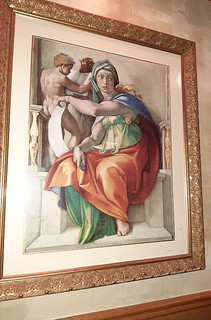 Tuesday, January 17 brought the first meeting of 2023 of my Northern Virginia Numismatic Social group Nummis Nova. I was the host and picked Ristorante Bonaroti in Vienna. I was assisted by Jon Radel who kindly offered to handle the restaurant reservation and announcements.
Tuesday, January 17 brought the first meeting of 2023 of my Northern Virginia Numismatic Social group Nummis Nova. I was the host and picked Ristorante Bonaroti in Vienna. I was assisted by Jon Radel who kindly offered to handle the restaurant reservation and announcements.
I arrived around 6pm and found Julian Leidman waiting in the parking spot next to mine. We were seated at a table a little small for our expected number and before ordering they thankfully relocated us. A recession may or may not be on the horizon, but business was booming at this classic Italian restaurant, with nearly every seat filled by the end of the evening and more people at the bar and outside on the porch.
COINS OF THE KINGS OF BITHYNIA
History has so much to teach us about history and geography. The latest Mike Markowitz CoinWeek Ancient Coin Series article discusses the Kings of Bithynia. Here's an excerpt - see the complete article online for more. -Editor
ALONGSIDE THE GREAT Seleucid and Ptolemaic empires that emerged from the breakup of Alexander the Great's empire following his death in 323 BCE, several small Greek-speaking kingdoms sprang up. Some of these produced exceptionally artistic portrait coins, and for almost two centuries, Bithynia's issues ranked among the finest.
Bithynia is a fertile, hilly region in the northwestern corner of Anatolia. In 297 BCE, Zipoetes, a tribal chieftain, declared himself king. Many years later, this date became Year 1 of the Bosporan Era
, used to date coins and inscriptions. Zipoetes ruled for an incredible 48 years, waging successful wars against neighboring kingdoms and expanding his territory. He was succeeded by his son Nikomedes, the first Bithynian ruler to issue coins in his own name.
ANOTHER SPONSIAN ARTICLE
Pablo Hoffman of New York City passed along this Atlas Obscura article on the Sponsian coin issue. It's based on the Hunterian Museum's research, and has some images we haven't published before. There's a funny typo in one of the captions: " images of the Hungarian Museum's Sponsian coin..." -Editor
In 1713, eight gold coins of five different designs were dug up in Transylvania, in modern-day Romania, and acquired by a man named Carl Gustav Heraeus. One of them featured a face and the name Sponsian.
Roman coins bore the faces of the ruler who issued them, even if his reign had been brief. The eight coins were discovered to have come from a larger hoard of gold coins that had been spread around at the time. Four Sponsian coins from that hoard are known to exist today. However, Sponsian's name doesn't appear in any ancient texts or sources. Over the years, the coins were written off as fakes—and the emperor was, too.
COUNTERFEIT BUST DIME DIE MARRIAGES
In today's JR Newsletter from the John Reich Collectors Society, author Winston Zack announced an interesting collecting milestone. -Editor
I am over the moon to share with the JRCS community that as of January 20th, 2023, I finally completed my Capped Bust ‘dime' die marriage collection. Why is ‘dime' in quotes? Because these are not your normal John Reich (JR) dime die marriages. Rather these are Zack (Z) hand-made, die struck circulating contemporary counterfeit Bust dime die marriages. And to my knowledge I'm the first person to have ever completed such a collection.
THE 1878 DRITANNIAR SIXPENCE
An interesting modern error coin was recently found by a detectorist. I was unaware of the "Dritanniar sixpence." -Editor
A Victorian silver coin uncovered by a detectorist turned out to be something of "a rarity" when the eagle-eyed finder spotted a spelling error on it.
The sixpence, dated 1878 and found in a Cambridgeshire field, bore the word "Dritanniar" instead of "Britanniar".
PAUL MORGAN APPOINTED KING'S ASSAY MASTER
The ancient Trial of the Pyx ceremony takes place each February. We usually discuss the event after the fact, but here's a story about the lead-up to the annual event, the appointment the Assay Master. The Royal Mint's Head of Coin Design Paul Morgan will take over that role in 2024. -Editor
The King's Assay Master role is appointed to serve the reigning monarch and to ensure the integrity of the British coinage and has existed for hundreds of years. The Assay Master role tests the quality of the coins and precious metals, underpinned by traditional craftsmanship and innovation at The Royal Mint. The role also includes upholding the integrity of UK Hallmarking standards by auditing the four UK Hallmarking offices annually in accordance with the Hallmarking Act of 1973. As The Royal Mint continues its transformation as a business, the role is rooted in the heritage and tradition that provides the 1,100-year-old business' authenticity and ensures the quality the Mint is known for.
Head of Coin Design Paul Morgan will take on the role following a thirty-year career at The Royal Mint. The centuries-old role will also be supported by a Deputy Assay Master, with Technical Manager Daniel Thomas being appointed to this position.
2022 COIN OF THE YEAR CATEGORY WINNERS
The category winners for the 2022 Coin of the Year competition have been announced. See the complete list in the linked Numismatic News article. -Editor
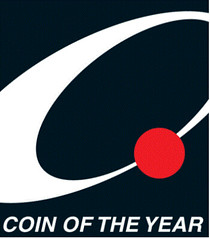 Canada was the country to beat as the best of the best went head-to-head in the first round of balloting for the 2022 Coin of the Year (COTY) Awards, an internationally conducted awards program recognizing excellence and ingenuity in coin design. The annual program, presented by World Coin News and sponsored by the Journal of East Asian Numismatics, honors 2021-dated coins issued by countries around the world.
Canada was the country to beat as the best of the best went head-to-head in the first round of balloting for the 2022 Coin of the Year (COTY) Awards, an internationally conducted awards program recognizing excellence and ingenuity in coin design. The annual program, presented by World Coin News and sponsored by the Journal of East Asian Numismatics, honors 2021-dated coins issued by countries around the world.
From a field of 100 coins put forth by the COTY Nominating Committee, judges were faced with tough competition from coins across the globe. Many mints had multiple nominations and voting was close in many categories, but there could only be one winner for each. While some categories had close calls, with the winners taking home the trophy with only a few votes to set them above others, others blew their competitors out of the water. Canada was one such example in Best Crown, winning the category with the most votes received across all categories of the entire COTY competition. Canada also won the Best Circulating.
FOIL-WRAPPED COINS
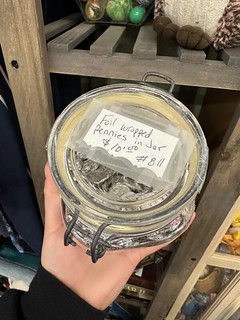
Tom Kays submitted this interesting article inspired by a social media discussion of cents wrapped in aluminum foil. Thanks! -Editor
Curses, Foiled Again?
During a recent shopping trip to the local antique mall, a shopper was perplexed to see a half-pint
mason jar full of foil-wrapped Lincoln Memorial cents. The tag read Foil Wrapped Pennies in Jar - $10.
The shopper photographed this strange treasure hoard and posted pictures on social media with the
question: Is there any reason why someone would wrap pennies in aluminum? Thanks in advance!
Social media being what it is, many comments soon rained down in response. Here are some of the
most apropos, plus others worthy of emoji awards.
THE MEDALS OF ISAAC SHELBY
Dennis Tucker published a nice article by Robert W. Shippee on medals of Kentucky Governor Isaac Shelby. Here's a short excerpt and some images - see the complete article online. -Editor
Moritz Fürst, a talented, if mercurial, engraver and die sinker, had the job of preparing many of the dies needed to strike the medals awarded to senior Army and Navy officers for their heroics in the War of 1812. Because of his work backlog, he did not finish preparing the dies used to strike the Shelby medal until May 1822. Fürst created the obverse die based on a portrait or sketch of Shelby but used a design prepared by the famous portrait painter Thomas Sully to sculpt the reverse die.
CAMBRIDGE ACTIVIST'S VENEZUELAN MONEY DRESS
Money can make a fashion statement as well as a political one, as with last week's item on Miss El Salvador's bitcoin outfit. Now an eco-activist in Cambridge, England has made a dress of Venezuelan banknotes. The photo on the steps of the Fitzwilliam shows posters for the current "Defaced!" exhibit on political slogans and money. -Editor
Cambridge-based Katherine Hasegawa organised an art activism performance to raise awareness of the situation at the Orinoco mining arc in the Venezuelan Amazon.
A former Anglia Ruskin University (ARU) student, who studied international business management, she most recently delivered her ‘ARTivist' message at the Fitzwilliam Musuem and the Cambridge Judge Business School.
LOOSE CHANGE: JANUARY 22, 2023
Here are some additional items in the media this week that may be of interest. -Editor
Mike Markowitz passed along this story of museum director convicted of swapping fake coins for real ones. Thanks. -Editor
he Court of Cassation upheld a decision by the Amman Court of Appeals to imprison a former Department of Public Antiquities museum director for five years. He was convicted of replacing 5,972 antique coins with fake ones.
Of the coins, 1,249 were gold, 4,478 were silver, and 245 were bronze, Al-Ghad News reported.
The value of the original coins was estimated at $1 million. The court fined the defendant a sum equaling the value of coins, in addition to trial expenses and any other expenses.
The former official was charged with a felony of embezzlement, and a misdemeanor of counterfeiting and falsifying antiquities.
The committee made an inventory of the artifacts, and it was found that some of the missing coins from the Jordan Antiquities Museum were sold outside the country.
To read the complete article, see:
Ex-museum director sentenced to prison for counterfeiting antique coins
(https://www.jordannews.jo/Section-109/News/Ex-museum-director-sentenced-to-prison-for-counterfeiting-antique-coins-26550)
Other topics this week include more counterfeiting, Red Tape, and opening "Vault Boxes". -Editor
FEATURED WEBSITE: FRENCH SCULPTURE CENSUS
This week's Featured Web Site is suggested by Scott Miller.
French Sculpture Census, French sculpture 1500-1960 in North American public collections
Scott writes:
"The number of French medals included is impressive."

